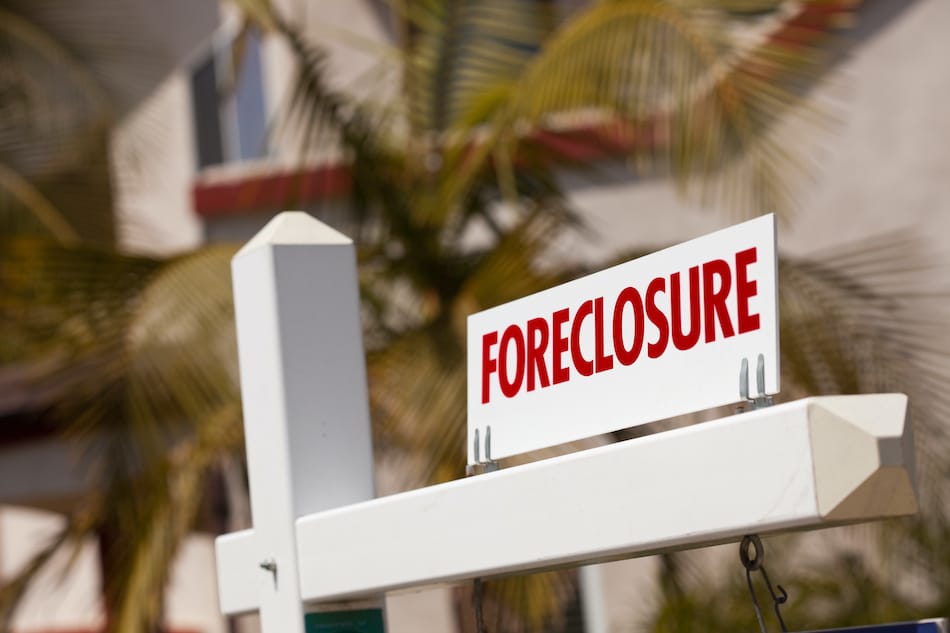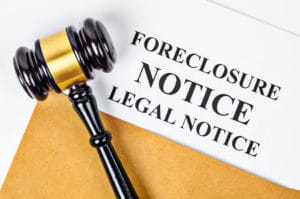 If financial difficulties prevent homeowners from making mortgage payments, homeowners can end up in foreclosure, a legal process that allows the lender to take control of the homeowner’s property and resell it to recoup the losses. In many states, foreclosure begins after four months of missed payments, though the process can begin sooner as most states follow their own processes. By learning the basics of foreclosure, homeowners can prepare for the upcoming process.
If financial difficulties prevent homeowners from making mortgage payments, homeowners can end up in foreclosure, a legal process that allows the lender to take control of the homeowner’s property and resell it to recoup the losses. In many states, foreclosure begins after four months of missed payments, though the process can begin sooner as most states follow their own processes. By learning the basics of foreclosure, homeowners can prepare for the upcoming process.
For informational purposes only. Always consult with an attorney, tax, or financial advisor before proceeding with any real estate transaction.
The Pre-Foreclosure Process
At the pre-foreclosure stage, the lender sends a late payment notice to the homeowner within 30 days of the first missed payment. If non-payment from the homeowner continues for two more months, the notice of default will arrive, leaving the homeowner to take immediate action toward stopping the foreclosure. If a homeowner waits for notice of default or ignores the lender, these actions will accelerate the foreclosure process. Homeowners who immediately reach out to their lender at the first sign of financial difficulties have the best chance at stopping the foreclosure.
Depending on the homeowner’s actions, the pre-foreclosure period can last up to ten months. Without a response from the homeowner, the lender can persue foreclosure; once the lender takes control of the property, it becomes available for sale at a public auction.
Special Considerations
One alternative to foreclosure is a short sale, an option where the homeowner retains control of the property and places it on the market themself. If the property is approved by the lender for a short sale, then the homeowner can sell the property for less than its market value and the total balance owed on the mortgage loan. Because lenders will lose money on the transaction, they must approve the short sale and will require the homeowner to create a short sale package, which will need to detail the financial hardships that caused the homeowner’s difficulties in making payments. The lender will review the paperwork in the package and then approve or deny the offer.
In determining if the short sale offer is the right decision for the property, lenders use a broker price opinion, or BPO, to understand the property’s value. A loss mitigation specialist uses the BPO to determine if the offer is high enough for acceptance. If the lender does not agree with the offer, they may submit a counteroffer to the buyer or reject it. Otherwise, the lender will issue their approval, allowing the purchase to move into closing.
Because short sales require extra steps compared to the traditional home buying process in addition to a longer approval period, buyers will need to wait for an extended period of time to purchase the property. This can complicate matters if homeowners do not have a real estate agent to educate all prospective buyers on what they will need to expect.
Benefits and Disavantages of Selling During Pre-Foreclosure
Short sales have benefits and disadvantages for lenders, homeowners, and buyers. Each party must weigh these factors to determine if a short sale is the right option.
For homeowners, selling during pre-foreclosure eases their financial burdens, as short sales do not impact a homeowner’s credit score as much as a foreclosure will. Additionally, homeowners who choose a short sale over a foreclosure will not have to complete the seven-year waiting period before acquiring another mortgage loan.
Because short sale homes sell for less than owed on the mortgage, lenders lose money on the transaction. However, the amount they lose is far less than a foreclosure, as foreclosures require administrative costs, legal fees, plus additional expenses related to preparing the property for the market.
Short sales attract buyers because the buyer can purchase their ideal home for less than market value. On the other hand, if the home is purchased as a foreclosure at an auction, then the buyer can have unexpected surprises ahead in the form of liens and unpaid taxes attached to the property. With its acquisition, the buyers are then responsible for those payments, possibly negating the money saved.
Judicial vs. Non-Judicial Foreclosure
In certain states, lenders can choose between judicial and non-judicial foreclosure, with the main difference being whether the courts are involved in the process. Depending on which one a homeowner is required to persue, they may have different ways to halt the foreclosure process. The timeline varies considerably between each option, especially in areas with overloaded court systems.
In either case, homeowners can benefit by talking to a HUD-approved counselor, as these experts can provide information about alternatives to foreclosure and offer guidance along the way. Alternatively, homeowners can reach out to a foreclosure attorney for help defending against the proceedings.
Judicial Foreclosure
During a judicial foreclosure, the lender must file the lawsuit with the local court and submit evidence of the default. Additionally, homeowners can submit their own evidence if they believe the lender has incorrect information. The assigned judge will review all evidence to determine if the claimed default on the loan occurred.
If the judge rules in favor of the lender, then the lender is granted permission to gain control of the property and place it for sale on the market. The ruling may also result in a deficiency judgement against the homeowner, which orders the homeowner to make payments on the difference between the amount owed on the loan and the final sale price of the property. In order to avoid a deficiency judgement, a homeowner can attempt to work with the lender to reach a settlement, which must occur before the judge’s ruling to provide enough time to withdraw the lawsuit. While waiting for the case to go through court, which can take up to one year, homeowners can seek alternatives to foreclosure such as a short sale or a deed in lieu of foreclosure.
Non-Judicial Foreclosure
A non-judicial foreclosure does not go through the court system; instead, the lender works with a foreclosure trustee, a neutral third party, to carry out the proceedings by assisting in every phase of the process and ensuring the lender complies with local laws.The foreclosure trustee’s first task is sending out the notice of default, which gives homeowners a chance to resolve the problem. The foreclosure trustee may give them a set amount of time to seek alternatives to foreclosure before moving onto the next step.
If the homeowners do not respond in a timely manner, then a notice of sale is the next step. In some cases, the lender does not have to notify the homeowner of the impending sale, as the lender is only required to post the notice on the property or in the local newspaper.
Because the lender does not have to wait for the court system, a non-judicial foreclosure often moves quickly. Within just a few months, the lender can take control of the property and place it for sale on the market, leaving homeowners with little time to find a resolution.
The Foreclosure Process Varies By State
Across the United States, 28 states allow non-judicial foreclosure, while the remaining 22 require the court’s involvement. Beyond that requirement, each state has its own foreclosure laws that control how lenders must complete the process, from the way lenders issue official notices to the homeowner’s available resolutions. Lenders must abide by these laws to gain control of the property and place it for sale on the market or the court could rule in favor of the homeowner. However, if non-payment from the homeowner continues, lenders may be able to restart the foreclosure process—as long as they proceed by abiding by state laws.
Minnesota Foreclosure Process
Minnesota allows lenders to choose between non-judicial and judicial foreclosures, with many lenders choosing the non-judicial route because it allows them to streamline the process. Due to a law granted in 2014, lenders still must wait before moving forward and are required to give homeowners 120 days to catch up on payments or seek alternatives to foreclosure.
Additionally, Minnesota state laws require lenders to send out a series of notices to help homeowners avoid losing their property. The first is the notice of default, which must allow a 30-day grace period for the homeowner to catch up on payments if possible. Following a notice of default, the lender must send a notice to the homeowner explaining foreclosure prevention counseling options as well as the homeowner’s contact information to an agency experienced in foreclosure prevention. Only after these notices are sent and the 120-day period has passed can lenders issue a notice of sale. Lenders are required to publish this notice for six weeks publicly before starting the sale process, and the homeowner must directly receive this notice at least four weeks in advance of the sale.
Each time the lender contacts the borrower, the lender must provide a foreclosure advice notice explaining how to avoid foreclosure and the expectations at the end of the process.
The Phases of Foreclosure
In every state, lenders experience the same six phases of foreclosure, with the first phase beginning with payment default and the process ending with eviction. Knowing what is ahead allows homeowners the best chance of resolving the issue before eviction arises. The following information explains what all parties involved in a foreclosure should expect in each phase.
Phase 1: Payment Default
Missing a single mortgage payment begins the foreclosure process, though lenders may not take the next steps for a month or more. Because foreclosure is expensive to complete, many lenders are open to working out a repayment plan with the homeowner. In order to gain the most flexibility, homeowners must contact their lender immediately upon realizing they cannot make their monthly mortgage payment. Once the homeowner calls, lenders will provide options that may help resolve the issue.
Beyond a repayment plan, lenders may offer alternatives to foreclosure, including:
- Short sale
- Deed in lieu of foreclosure
- Forbearance
- Refinance
- Loan modification
If homeowners do not contact their lender, they will receive missed payment notices and demand letters in the mail. These documents offer 30 days to catch up on payments before moving onto the next phase of foreclosure.
Phase 2: Notice of Default
After a notice of default has been sent to the homeowner, the foreclosure process officially begins. Depending on whether the foreclosure is a non-judicial or judicial process, this notice will be submitted to the homeowner and the court, if applicable. When sent to the homeowner, the notice of default usually arrives as certified mail, which provides the lender with a receipt and verifies the delivery.
The notice of default reflects the breach of contract that occurred by the homeowner’s missed payment. By issuing this notification, lenders are able to take control of the property and place it on the market for sale. Additionally, this phase gives homeowners a chance to avoid foreclosure or potentially retain the rights to their property.
Phase 3: Notice of Sale
After 120 days of non-payment, homeowners will receive a notice of sale explaining the amount owed in missed payments and when the sale is expected to go through, providing homeowners time to secure housing and move out of the property.
Additional information in the notice includes:
- Property address
- Legal description
- Name of owner
- Sale date
- Where the sale will occur if going to auction
In some states, the homeowner must be notified by the lender directly, while other states allow the notice to be placed on the property. Additionally, most states require the lender to publish the notice of sale publicly in the local paper.
Phase 4: Trustee’s Sale
Most foreclosures go to auction in an effort to sell them quickly and minimize the lender’s losses. When placed on public auction, the property sells to the highest bidder who abides by the requirements, including:
- Paying the initial deposit in cash
- Securing financing ahead of time
- Issuing full payment within 10 days
Buyers of foreclosed properties must also be willing to take responsibility for any liens and back taxes attached to the property. In some cases, buyers can acquire title insurance through escrow or after closing to potentially protect themselves from those additional obligations. Because properties are sold as-is, all necessary repairs become the buyer’s responsibility, regardless of whether the buyer has obtained title insurance.
Phase 5: Real Estate Owned (REO)
If the property does not sell at the public auction, then it becomes real estate owned, or REO. Upon gaining ownership, the lender has the ability to remove liens, pay back taxes, and otherwise clear the title of any defects. Additionally, lenders are able to perform any maintenance and repairs needed to prepare the residence for the market. Through these steps, lenders present the property as more desirable to prospective buyers, which can help the property sell faster and potentially at a higher price.
Phase 6: Eviction
Homeowners can remain in the home until it is sold. Once the sale has been completed, an eviction notice is sent to the homeowner, which includes an official move-out date. Depending on the buyer’s plans for the property, there may be a few arrangements for the previous homeowner to consider, such as:
- Buying back the home from the buyer by paying the full purchase price, interest, and other costs
- Residing in the home until the end of the redemption period
- Living in the property as a tenant and making monthly rent payments
- Cash for keys arrangement, where homeowners trade the keys for a lump sum payment to help them find new housing
While the foreclosure process is difficult to navigate, homeowners can rely on their lender for support. Because they want to avoid foreclosing on the property as well, many lenders will offer alternatives in order to help homeowners resolve their financial difficulties and keep their property.
In order to work toward a mutually satisfactory resolution, homeowners must reach out to their lenders as soon as the homeowner knows they will miss a mortgage payment. With this action, homeowners can start working with their lender toward suitable alternatives and prepare for the foreclosure process if it is determined to be unavoidable.
For informational purposes only. Always consult with an attorney, tax, or financial advisor before proceeding with any real estate transaction.



